|
Nurhachi and the system of "Eight Banner"
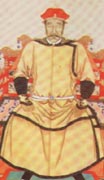 Nurhachi (1559-1626), the Qing Tai Zu, was from Zuowei(Xinbin county in Liaoning province, nowadays) in Jian state. His family name was AisinGioro. The position of the leader of Nuchen was hereditary in his family. He had a good command of Chinese language and Manchu language and was greatly influenced by the Han nationality culture. The eleventh year of Wanli period of Ming Dynasty (1583), he began the unification of the Nuchen tribes. By the forty-fourth year of Wanli period (1616), he had unified all the Nuchen tribes and established the Posterior Jin power in Hetuala (later, the capital was changed to Xingjing, west of Xinbin of Liaoning province nowadays), and began the period of Tianming. In the forty-sixth year of Wanli period of Ming Dynasty (1618), he declared to overthrow the Ming rulers, with his "Eight Banner" powerful force. In March of the next year, he won the key success against Dusong's army that was the main force of Ming army. From then on, the Posterior Jin developed into the aggression phase from the defense phase. In the first year of Tianqi period of the Ming Dynasty (1621), Nurhachi led the "Eight Banner" army and the Mongolian army to attack the Ming army and occupied Shenyang and Liaoyang. The next year, he occupied such fortress as Xiping fort and Guangning. In the fifth year of Tianqi period (1625), he moved the capital to Shenyang. In the eleventh year of Tianming period of Posterior Jin (1626), he led the "Eight Banner" army to occupy Jinzhou and Ningyuan. In Ningyuan, he was beaten by Yuanchonghuan, a Ming general, and was badly hurt. In August of the same year, Nurhachi died. His position was hereditary to his eighth son, HuangTaiJi. Nurhachi (1559-1626), the Qing Tai Zu, was from Zuowei(Xinbin county in Liaoning province, nowadays) in Jian state. His family name was AisinGioro. The position of the leader of Nuchen was hereditary in his family. He had a good command of Chinese language and Manchu language and was greatly influenced by the Han nationality culture. The eleventh year of Wanli period of Ming Dynasty (1583), he began the unification of the Nuchen tribes. By the forty-fourth year of Wanli period (1616), he had unified all the Nuchen tribes and established the Posterior Jin power in Hetuala (later, the capital was changed to Xingjing, west of Xinbin of Liaoning province nowadays), and began the period of Tianming. In the forty-sixth year of Wanli period of Ming Dynasty (1618), he declared to overthrow the Ming rulers, with his "Eight Banner" powerful force. In March of the next year, he won the key success against Dusong's army that was the main force of Ming army. From then on, the Posterior Jin developed into the aggression phase from the defense phase. In the first year of Tianqi period of the Ming Dynasty (1621), Nurhachi led the "Eight Banner" army and the Mongolian army to attack the Ming army and occupied Shenyang and Liaoyang. The next year, he occupied such fortress as Xiping fort and Guangning. In the fifth year of Tianqi period (1625), he moved the capital to Shenyang. In the eleventh year of Tianming period of Posterior Jin (1626), he led the "Eight Banner" army to occupy Jinzhou and Ningyuan. In Ningyuan, he was beaten by Yuanchonghuan, a Ming general, and was badly hurt. In August of the same year, Nurhachi died. His position was hereditary to his eighth son, HuangTaiJi.
Eight banners:
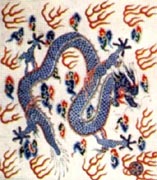 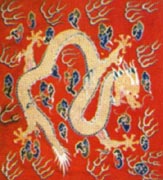
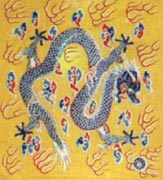 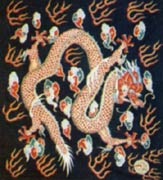
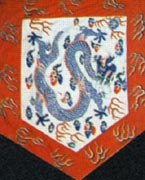 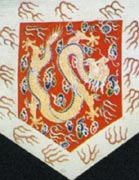
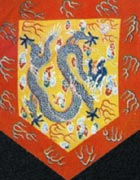 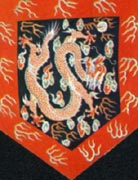
The system of "Eight Banner" was a form of social institution in Qing Dynasty. In the peacetime, the Eight Banner were farming and hunting as common people while in the wartime, they were fighting as soldiers. The system of Niulu was originated in Qing Dynasty. To meet the need of war, Nurhachi adapted the system of Niulu that was a temporary organization for production and military affairs into a long-term formal organization. It was regulated that 300 persons formed a Niulu and every Niulu should have a Niulu Ezhen (Watch Leader). Five Niulus should have a Jiala Ezhen (Canling) and every five Jiala formed a Gushan, that is, a banner. The leader of a Gushan was Gushan Ezhen (commander-in-chief). In 1601, Nurhachi set up the yellow banner, the white banner, the red banner and the blue banner. In 1615, he also set up the border yellow banner, the border white banner, the border red banner and the border blue banner. All those banners were called "Eight Banner" by a joint name. Nurhachi assigned his sons and nephews as the leader of the eight banners and those leaders were called "Gushan Beile". In 1635, he set up Mongolian "Eight Banner" and in 1642, "Eight Banner" of the Han nationality. So, there were in all twenty-four banners but customarily they were still called Eight Banner. The "Eight Banner" had military, political and producing function. The member of "Eight Banner" was called "banner man". As the ruin of the Qing Dynasty, the system of "Eight Banner" also died out.
The legend of rescuing Nurhachi and the respect for dogs and crows
<<
Respecting ancestors and emending family tree
>>
|

